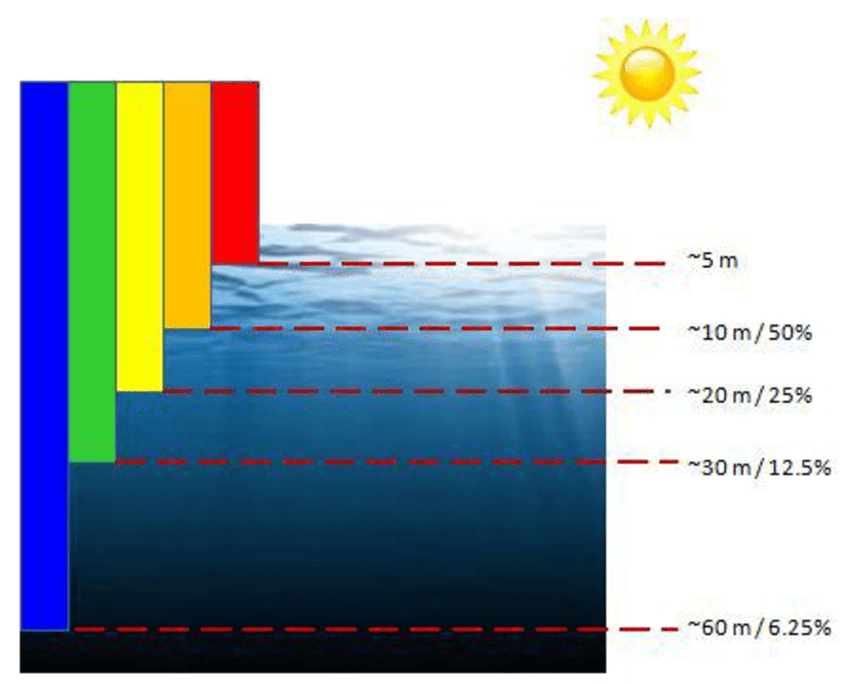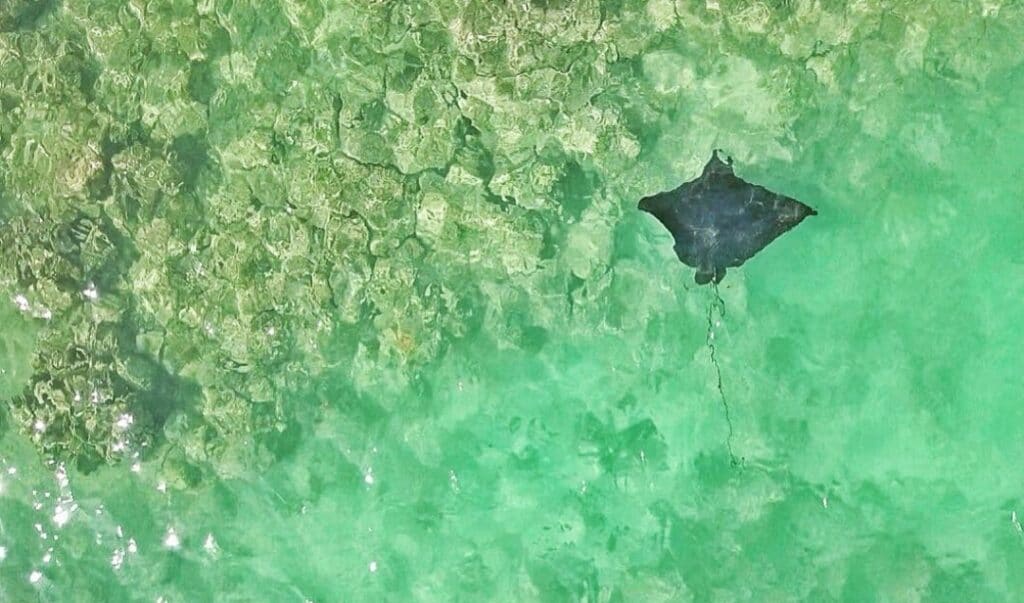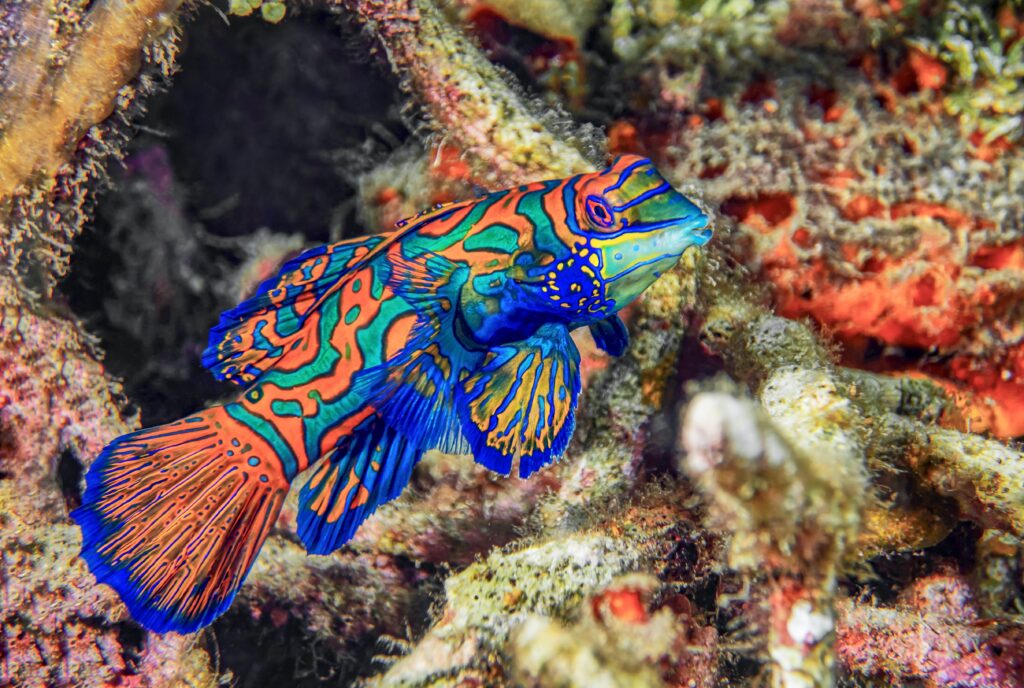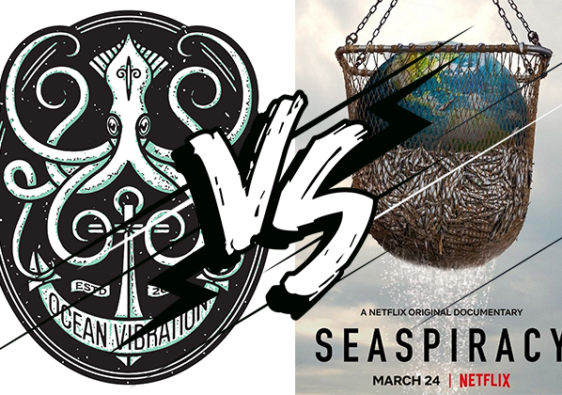If you ever snorkeled or scuba-dived, you had the chance to discover the amazing colors of the ocean. The ocean itself can be of many shades and, its inhabitants display the greatest array of colors.
So let’s dive in and explore the different colors of the ocean!
Table of contents
Is the ocean really blue?

When wondering about the color of the ocean, we simply need to look at what is the ocean made of; water.
Water, though transparent when looking at it in small quantities like in a glass of water, seems completely colorless. But the fact is that water is actually blue, or has a tint of blue to be more precise.
The blue color of water actually becomes apparent as we look down through a water column. This will reveal that the water gets its tint of blue from the water molecules absorbing the red in the spectrum of ambient light.
What color does the ocean absorb?

As most scuba divers surely know, red is the first color that gets absorbed by water. When we go diving, we don’t actually see the actual colors of the underwater world. That is the main reason why underwater video enthusiasts will use red filters while filming with their action cameras.
The different colors that make up light get absorbed by the water molecules with red having the longest wavelength and blue and violet the shortest. If you go deep enough (past +/- 60 meters), even the blue color gets totally absorbed, leaving a pitch-black ocean below as no more light can penetrate.
This deepest part of the ocean, where no light can penetrate is called the Bathypelagic zone or the ‘cooler’ name Midnight zone.
Go in-depth details with this NASA Science article!
What are the different colors of the ocean?

The ocean color that I love the most is the deep blue one from the deep ocean; yes I know, everyone else loves the turquoise one!
The difference between the turquoise and deep blue color comes from the depth of water we are looking at. The beautiful turquoise water that we see from above comes from the fact that the reflection of light from the sandy bottom goes through enough water to remove the red wavelength. The deep blue ocean color on the other side is the color left from the other colors being absorbed.
Ocean water can also appear in different colors such as green or brown. This can be due to 2 different possibilities, being either the presence of suspended particles or dissolved matter.
The green color of the ocean is often due to the presence of algae suspended in the water column. On the other side, water can be noticeably brown or orangeish in shallow areas with dead leaves in the water. That is due to dissolved matters in the water such as you can see in your cup of tea.
Why are some seas named after colors?
Our planet has 4 distinct seas with colors in their name. They are the red, white, black, and yellow sea
Red Sea (map)
The combination of desert sand blowing in the sea and cyanobacteria creates a reddish tint.
White Sea (map)
The frozen water (as it often is) gives a white look to the sea.
Black Sea (map)
History seems to point out the fact that this sea got its name from the fact that the sea was inhospitable and hard to navigate.
Yellow Sea (map)
The sea yellow because of the huge amount of mineral-rich soil that flows down from the rivers.
Can fish see colors as we do?

This question arises the most in 2 scenarios. People always wonder if wearing red in the water is a bad idea because of sharks. And then fishing enthusiasts often wonder which color lure to use to catch fish.
The fact is that most fish actually see in full color as we do. Some, like the goldfish, even see in ultraviolet light. And, to everyone’s surprise, sharks actually don’t see colors.
Sharks actually cannot distinguish between colors as we do and only see in black and white. Though on the other side, they see contrasts in the water really making popping colors more likely to attract their attention.
Go in-depth with this great article from MidCurrent!
Why are fish of different colors?

Now when we look at red and as we know in the above water natural world, red is the color that attracts. So why would fish evolve to be red?
A fisherman will tell you that red-colored fish are deep in the water column, and that is most often the case. As we have read earlier on the absorption of color by water, red is the first color to disappear in water. As such, compared to the surface, a red-colored fish underwater has an advantage when deep enough.
Another amazing fact that nature lovers may have noticed is that blue is the rarest color in nature. Two amazing species, one on land and the other in the ocean, are the rare ones to produce blue pigment. They are the Olivewing butterfly and the Mandarin fish (picture above).
The inhabitants of the ocean use colors in many ways. They use colors to display upcoming actions, sex, and danger. Such is the case of the Ribbon eel that changes color and sex during their lifetime (as shown in the video below).
Fish often use color to communicate as well. The sailfish is a prime example of that, with the ability to switch between blue, black, and stripe in order to communicate their intention to attack prey to their peers.
You can discover a world of incredible underwater colors in the book Reef Life: A Guide to Tropical Marine Life.
Now, let’s find out more about Eagle Rays, another amazing marine animal!
** DISCLAIMER **
This article may contain affiliate links. Those links are at no cost to the reader and help OceanVibration continue to share great content. Thank you for your support!





very interesting article Mr Ocean
Glad to be able to share my knowledge and passion with you!
[…] White balance is one of the most important factors when filming underwater.That is because of the penetration of light through the water column. […]
[…] secret lies in grabbing the true colors of what you are shooting. To have video footage that is closest to real life. That’s why I often say that your lights are […]